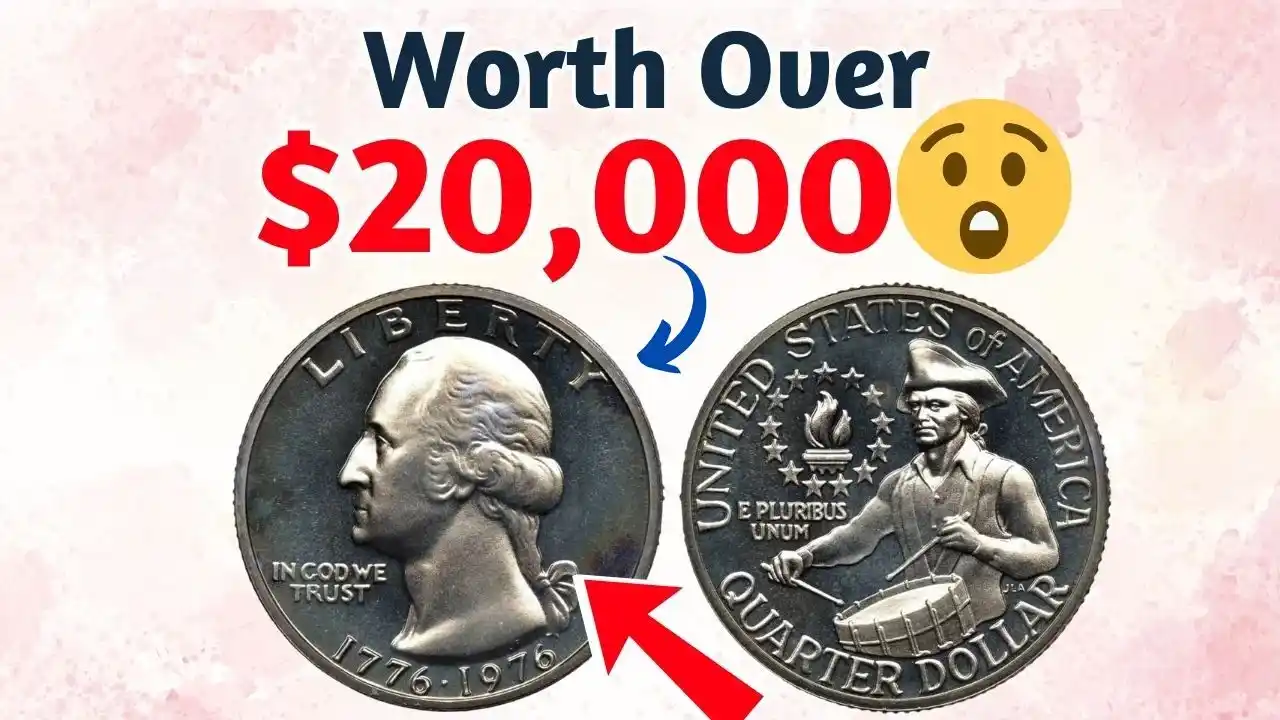Rare 1976 Bicentennial Quarter How much is that 1976 coin worth now? Many people think of coins as common everyday items, but some coins hold surprising secrets. One such coin is this 1976 coin. For years, it seemed like common pocket money. But recently, collectors have discovered that some of these coins are worth a lot of money—more than $20,000, in fact. That’s why many people are rummaging through their pots of old coins in search of hidden treasures.
Most people see coins as everyday change, but sometimes, they carry hidden treasures. One perfect example is the 1976 Bicentennial Quarter — a coin that might look ordinary but, in rare cases, can be worth more than $20,000. This surprising fact has inspired many to dig through old jars, wallets, and coin collections in hopes of striking it rich.
Why the 1976 Quarter Was Unique
The year 1976 marked America’s 200th anniversary, known as the Bicentennial. To commemorate the occasion, the U.S. Mint released quarters with a one-time-only reverse design. Instead of the usual eagle, these coins featured a Colonial-era drummer boy with a torch and victory wreath.
Millions were produced for circulation, but only a small number were made under unusual conditions or with errors — and those are the coins that fetch big money today.
What made the 1976 quarters special
The year 1976 was America’s 200th anniversary—also known as the Bicentennial. To celebrate this special occasion, the U.S. Mint issued special quarters with a different design than usual. Instead of the usual eagle, the reverse of the coin featured a picture of a drummer and a torch. These were called “Bicentennial quarters,” and millions of coins were made. Most were normal coins. But some rare quarters were made differently or with minor errors. These are quarters that can be worth a lot today.
Rare types that collectors love
Not all 1976 quarters are valuable. Most are still worth only 25 cents. But rare quarters—such as those made of silver, coins with mint errors, or proof versions—are sought out by collectors. Some coins were minted on silver planchets (blank pieces of coin), although most were made of normal copper-nickel. Some also have errors such as double seals or off-center printing. These are rare varieties that command very high prices.
The Types Collectors Search For
While most 1976 quarters are only worth their 25-cent face value, certain varieties are worth hundreds or even thousands of dollars. Collectors especially look for:
-
Silver Bicentennial Quarters – Some were struck on 40% silver planchets instead of the usual copper-nickel.
-
Error Coins – Examples include double strikes, off-center prints, or other minting mistakes.
-
High-Grade Proof Coins – Special coins made for collectors with sharp, flawless details.
The rarer the condition or error, the higher the value.
The $20,000 Bicentennial Quarter
One of the most famous Bicentennial quarters sold for over $20,000 at auction. This particular coin was struck on a silver planchet, displayed a sharp and flawless design, and was preserved in perfect condition for decades.
Its exceptional grade, awarded by a professional coin grading service, made it one of the finest known examples — which sent collectors into a bidding frenzy.
Where You Might Find One
The best part? These valuable coins aren’t all locked in museums. They can still appear in old coin jars, piggy banks, inherited collections, or even in spare change. If you come across a Bicentennial quarter, take a closer look — especially if it seems heavier, shinier, or has unusual markings.
How to Tell If Your 1976 Quarter is Valuable
While professional evaluation is the most reliable way, here are quick checks you can do:
-
Look for Silver – A brighter, shinier surface and heavier weight can be a clue.
-
Check for Errors – Off-center strikes, doubled images, or unusual text.
-
Condition – Mint-state or proof coins with no scratches are the most valuable.
Coin shops and grading services like PCGS or NGC can confirm authenticity and value.
Why People Still Love Collecting Coins
For many, coin collecting is more than a hobby — it’s a connection to history. Each coin tells a story about its era, its production, and sometimes, the people who carried it. The 1976 Bicentennial Quarter is a reminder that even an object as small as a coin can hold significant historical and financial value.
Don’t Ignore Your Spare Change
Before you spend or toss that quarter into a jar, give it a second look. You could be holding a valuable piece of American history — and maybe even your next big payday.
Value Comparison Table for 1976 Bicentennial Quarters
| Type of 1976 Quarter | Estimated Value (USD) |
|---|---|
| Regular Circulation Quarter | $0.25 (face value) |
| Bicentennial Silver Proof Quarter | $5 – $20 |
| Error Quarter (misprint/misstrike) | $100 – $1,000+ |
| High-Grade Silver Quarter (MS67+) | $2,000 – $20,000+ |
Quick FAQs
Q1. Is every 1976 Bicentennial quarter valuable?
No. The majority are worth only face value. Only coins with silver content, errors, or exceptional grading are valuable.
Q2. How do I know if mine is silver?
Silver quarters weigh slightly more and have a brighter, less coppery edge. You can also check for an “S” mint mark (San Francisco), which often indicates a proof or silver coin.
Q3. Where can I sell a valuable Bicentennial quarter?
Through coin dealers, auction houses, or online marketplaces like eBay. Having it graded first will boost its value.
Q4. Why did the U.S. Mint change the design in 1976?
It was part of the celebration of America’s 200th anniversary, making these coins historically unique.
Q5. Are silver Bicentennial quarters still found in circulation?
Yes, but it’s rare. Most were saved by collectors, yet some still slip into everyday change.
